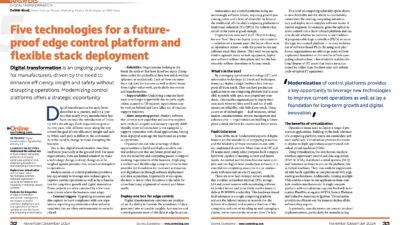Manufacturing is becoming more automated and specific as consumer tastes change. Manufacturers need to adapt to this changing landscape and digital transformation can play a key role.

Learning Objectives
- Understand what digital transformation is and its role in manufacturing.
- Learn how digital manufacturing can address critical challenges in manufacturing.
- Learn about the benefits of implementing digital transformation.
Digital transformation insights
- Digital transformation’s role in manufacturing is growing as automation takes on a greater role in day-to-day operations.
- System integrators can help with the digital transformation journey because they often play a key role in information technology/operational technology (IT/OT) matters and can help bridge a gap that continues to persist in manufacturing.
The days of push-button technology and manual operations in manufacturing are in the rearview mirror. Automation and analytic advances have transformed the industry and will help us weather the storm of hardware obsolescence, security risks and the overwhelming workforce shortage. Pursuing digital transformation is the only way to stay competitive in today’s environment. Fortunately, it’s achievable, and there are many experts who can help.
Digital transformation’s role in manufacturing
Essentially, digital transformation is the process of bringing the technology in a plant forward. Whether these processes are currently manual or semi-automated, the goal is to end up with fully automated, streamlined processes that provide companies with rich digital information to see how the plant is doing and find areas to improve.
The path taken to achieve this goal varies and depends on what kind of technology is used. In most cases, the process involves adding more data infrastructure to house the information to be delivered and upgrading hardware to accommodate the programmable logic controller (PLC).
Three reasons why digital transformation is crucial for manufacturing
There are several major reasons to actively pursue digital transformation in today’s changing industrial climate. Three of the most pressing are:
-
Hardware obsolescence. Every manufacturer upgrades its products eventually and may quit making those parts. For reliability’s sake, companies need to upgrade equipment to have the right parts available in case of failure. This problem is partially solved by digital transformation because, after an evaluation, they will have a database or dashboard of all gear and devices with lifecycle and manufacturer information. This will help companies develop a replacement schedule that helps with budget and avoid unplanned downtime.
-
Stories in the news where a cyberattack shuts down a major organization or plants being taken offline are prevalent. Having the proper digital infrastructure can help protect a plant and assets from cyberthreats.
-
Worker shortage. According to the U.S. Chamber of Commerce, ‘The manufacturing industry faced a major setback after losing roughly 1.4 million jobs at the onset of the pandemic. Since then, the industry has struggled to fill job vacancies. As of January 2023, there were 803,000 open manufacturing jobs.” Finding skilled workers to fill open positions is daunting, but automation can help. Generally, the more automated the plant, the fewer workers are required. The COVID-19 pandemic showed companies how to run a plant with the least amount of people possible. An automated workforce can help drive that, and a streamlined process reduces challenges if there’s a workforce shortage
How manufacturers can start on their digital transformation journey
First, companies need to understand where the plant sits on the spectrum of digital transformation. An evaluation will cover the basics and ask questions companies might not think about regularly. Where does the infrastructure sit today? What hardware does the company have? Are any future expansions planned? Are servers up to date on patches? If a gear fails, does the manufacturer still make and sell the needed parts?
Companies need a baseline evaluation of the systems and processes to gather this information and then feed it into an analytics solution.
Some organizations have knowledgeable personnel in-house who can perform these evaluations and put together a digital transformation plan. If that’s not an option, there are many experienced systems integrators who can help.
Four benefits of implementing digital transformation
Once the work is done, companies might be wondering how it’s paying off. Some benefits might be hard to quantify, but they are valuable to know.
-
Enhanced cybersecurity. The right infrastructure in place will help companies protect plant assets from attacks,
-
Improved product quality. With automation, the machines do the work including batch testing and quality analysis. If there’s a recall from a supplier for one specific ingredient, a digital system makes it easy to go in and find and report on everything that ingredient went into.
-
Fewer workers on the plant floor. Automated systems will also help companies through the workforce shortage by reducing the need for operators.
-
Better decisions. The data from a digital transformation will give visibility into equipment and processes that can be used in many ways. If an expansion is planned down the road, having this data ready will help companies make smarter business decisions.
A good example of digital transformation in action involves a recent project. A client’s pellet mill was a manual operation. Someone would have to sit beside certain pieces of equipment, adjusting settings all day. After an audit and upgrades, the plant’s throughput nearly doubled per day. Data analytics for the plant was provided to see costs, throughput, quality and more. They now have reporting functions available about tolerances, what ingredients are going in, and all information to understand what it takes to make a product today.
A qualified partner will help determine the right path forward for a plant regarding digital transformation. It’s not just swapping out hardware. Companies need to think about what tools are available today and what is planned for the future. Companies shouldn’t pigeonhole themselves with only an obsolescence upgrade. They can include many elements in the process that will ultimately add value. Plan to fully modernize, even if that takes time, and give the organization the foundation of information they’ll need.
Cary Bandstra is lead control systems analyst at Interstates, a CFE Media and Technology content partner. Edited by Chris Vavra, web content manager, Control Engineering, CFE Media and Technology, [email protected].
Consider this
How can digital transformation help your manufacturing facility?


